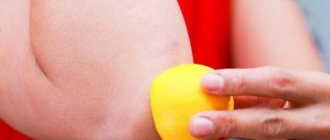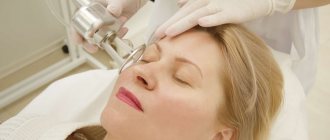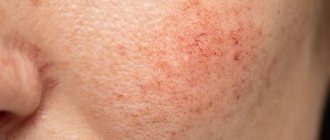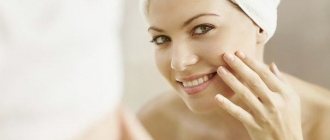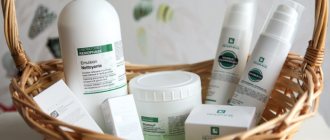Women have been using AHAs (fruit acids) since ancient times and knew about their drying, renewing and sebum-regulating properties. Cleopatra, one of the most famous beauties of antiquity, added citrus fruits and berries, which are rich in fruit acids, to her masks. Nowadays, every woman has heard about the benefits of acids, but not everyone has dared to try them. There is no need to be afraid of this component! The main thing is to choose a product that suits your skin type. We tell you why AHAs are needed, who they are suitable for, how to use them and what to choose.
The concept of the technique and its advantages
AHA peeling effectively cleanses the skin of blackheads
Peeling with fruit Alpha-hydroxy acids (AHA) destroys the bonds between keratinized epithelial scales and leads to their active exfoliation or desquamation.
Based on histological examination of the skin surface under a microscope after such peeling, the following results were noticed:
- reducing the degree of keratinization of cells in hair follicles;
- removal of comedones (blackheads);
- reduction of inflammatory processes around hair follicles;
- restoration of normal outflow of sebum;
- improving oxygen saturation of cells;
- increasing the permeability of the skin surface for deep penetration of any cosmetic preparations;
- significant reduction in the proliferation of pathogenic anaerobic bacteria.
Possible side effects
When performing AXA peels using natural fruit acids, the following adverse reactions of the body can be observed :
- local irritation of the epidermis - itching, discomfort, burning;
- areas of the skin become darker in color;
- swelling appears, which goes away in one day;
- the skin becomes more sensitive to air temperature and exposure to the sun;
- the peeling process increases;
- the appearance of mini-burns, microtraumas that pass very quickly;
- there is a feeling of tightness and, in places, dryness.
Peeling should occur after peeling - this is a natural reaction of the skin . It can last up to 10 days. Not every acid causes active peeling. For example, milk and glycolic products rarely give such an effect.
If you take proper care of your skin after the procedure, all side effects will disappear within a maximum of 3 days. But if they continue to intensify, consultation with a cosmetologist is necessary. There is no need to endure unpleasant acute reactions - you should stop the procedure and consult a doctor.
Types of acids used
The most popular AHA peels are procedures using mandelic, glycolic and lactic acid. Let's look at each of them in more detail.
- The almond type of peeling is as gentle as possible, therefore it is recommended for use even for overly sensitive types of epidermis, as well as in the presence of rosacea (vascular network). In addition, it is widely used to cleanse problem skin;
- Glycolic peeling is considered the most popular because it can solve several skin surface problems. In addition to eliminating all kinds of epidermal defects, it serves as an excellent prevention of aging and effective correction of age-related changes in skin tissue;
- milk peeling not only cleanses the skin well, but also moisturizes it, therefore it is used for dehydrated and aging epidermis.
For alpha-hydroxy peeling, citric, malic and tartaric acids, or combinations thereof, are also used.
Only a cosmetologist should decide what type of fruit acid to use after assessing the initial condition of the patient’s skin surface, taking into account his age, the presence of problems and defects that need to be eliminated.
AHA acids - what are they and what are they for?
The abbreviation AHA has already become synonymous with fruit acids, which got their name due to the fact that they are extracted from fruits and berries. But this is not entirely true. Fruit acid is just one of the varieties of alpha hydroxy acids (the same abbreviation AHA on the packaging). Alpha hydroxy acids include fruit acids (malic, citric, tartaric) and lactic, glycolic and almond.
The mechanism of action for all acids is the same. It is essentially based on a chemical burn. The extent to which the acid will damage the skin depends on what variety we have in front of us and what its concentration and pH (acid-base balance) are. The more concentrated the acid, the higher its acidity, and the more aggressive its effect on the skin. But the action of almost any peeling is based on the damage process. Acids dissolve dead epidermal cells, activate the formation of new ones, launch the process of intensive cleansing and renewal of the skin, and also improve the penetrating effect of other products.
Benefits of acids for skin:
- Exfoliate dead particles and launch restoration processes in cells
- Improves the functioning of the sebaceous glands
- Moisturizes and normalizes the hydrolipid barrier
- Smoothes out small wrinkles and reduces the depth of facial expressions
- Strengthens collagen and elastin fibers
- Have anti-inflammatory and antioxidant effects
- Lighten hyperpigmentation
- Evens out the relief and complexion
- Reduces the appearance of scars and post-acne
What are the types of AHA acids for skin?
- Apple juice (mainly extracted from apples, but also found in other fruits and berries, for example, grapes, tomatoes) - suppresses the activity of harmful bacteria, cleanses, and evens out.
- Lemon (found in citrus fruits, cranberries, currants and some fruits) - helps get rid of dead cells, dissolves sebum and impurities in the pores. Not recommended for use in active sun, as it increases sensitivity to UV rays.
- Pyruvic acid (found in the acidic juice of many plants, but more often extracted from grapes) - valued for its pronounced anti-aging effect.
- Glycolic (usually obtained from green grapes or sugar cane) - smoothes wrinkles, activates the production of collagen and elastin, and cleanses.
- Lactic (formed during lactic acid fermentation of sugars, present in the body naturally) - suitable for use in summer, moisturizes, soothes, and has a slight exfoliating effect.
- Almond (extracted by hydrolysis from bitter almond kernels) is the softest, as it works on the surface of the epidermis.
Efficiency of the technique
The result of the procedure after alpha-hydroxy peeling will be:
- improvement of complexion;
- smoothing the skin surface from fine wrinkles and reducing the severity of deep ones;
- whitening pigment spots;
- increasing the moisture and elasticity of the epidermis;
- narrowing of enlarged pores;
- normalization of sebaceous secretion production;
- reduction in the number of rashes (blackheads, pimples, acne);
- elimination of comedones.
Photos before and after the AHA peeling procedure
What is chemical AHA facial peeling?
AHA facial peeling is a treatment of the skin with fruit acids . As a result, the stratum corneum of the epidermis begins to peel off, and dead cells are gently removed.
The appearance of the skin becomes blooming, and the surface becomes soft and delicate. The procedure comes from the times of Ancient Egypt and Greece, when people used the juices of fruits, berries, and sugar cane to rejuvenate the skin.
At all times, women make themselves masks from yogurt, strawberries and other natural products. Therefore, AHA peeling is not such a new and modern procedure. It has proven its effectiveness over many centuries.
Features and components
There are several popular types of AHA peels. This is skin cleansing with lactic and glycolic acid. No less often used are the following: lemon, apple, wine. In cosmetology practice, a combination of several acids is used at once .
When choosing peeling components, it is necessary to take into account age, existing skin problems, its condition, as well as many other factors.
If you carry out the procedure at home, it is advisable to consult a professional cosmetologist who will evaluate the appearance of the skin and tell you what is best for it at the moment.
Effect on skin
AHA peeling is a kind of chemical burn of the epidermis . In this case, the depth of the burn is controlled by a cosmetologist - everything happens under strict supervision, and acids are taken in the required proportions. Chemical peeling works in such a way that under its influence, regenerative processes are launched in the skin. Cell regeneration accelerates, some visible problems are eliminated, the skin becomes young and blooming, and its relief is evened out.
Also, in addition to all this, acids also affect the sebaceous glands, cleansing their ducts. There is control over the secretion of sebum, due to which:
- the epidermis becomes less oily;
- the risk of pimples and blackheads is reduced.
Fibroblasts are stimulated, skin elasticity and firmness increase . Due to the fact that collagen synthesis becomes higher:
- the epidermis is smoothed out;
- fine wrinkles that indicate age disappear.
Efficiency
AHA chemical peel provides immediate visible results:
- the skin ceases to be dry, becomes naturally moisturized and softened;
- elasticity increases;
- color improves - the shade is evened out, age spots and inflammation are eliminated, pallor and yellowness disappear;
- small wrinkles are smoothed out, and deep ones become less pronounced and obvious;
- the problem of wide pores is solved - they noticeably narrow, and the number of acne lesions is significantly reduced.
It is worth remembering that superficial peeling cannot solve advanced skin problems , for example:
- tighten sagging;
- correct unclear facial contour;
- erase absolutely all age spots and remove old scars.
Also, deep age wrinkles cannot be completely smoothed out. Therefore, you should not expect magical miracles from peeling in extremely unhealthy skin conditions and place unjustified hopes on the procedure.
How to prepare for manipulation
A prerequisite for preparing for AHA peeling is to avoid prolonged exposure of the facial skin to direct ultraviolet rays 2 weeks before the scheduled day.
To increase the effectiveness of the procedure, 2 weeks before the start of its passage you should
use gels, lotions or creams with alpha hydroxy acids for home use, which can be purchased from a cosmetologist or in online stores.
An analogue of pre-peeling preparation is 1-2 peeling sessions with the lowest possible concentration of glycolic or mandelic acid.
Who is suitable for and how to use acids for the face
AHA acids are well suited for the care of aging skin that has undergone photoaging, the formation of age spots and wrinkles. For young normal to dry skin. Despite their high acidity, AHAs retain water in cells and stimulate the formation of elastin and collagen, so the skin remains young and radiant for a long time. Those with oily and problem skin should take a closer look at BHA acid, as it is fat-soluble (unlike AHAs, which dissolve in water) and acts effectively inside the pores, preventing the appearance of oily shine and acne.
If you have sensitive skin, we recommend starting with a low concentration and gradually increasing the level. In beauty products for home care, the concentration of acids does not exceed 10%, which is acceptable. At the same time, up to 5% AHAs do not exfoliate, but retain moisture. Products with a concentration above 10% require neutralization and are intended for salon care strictly as prescribed by a doctor and under the supervision of a specialist.
Main stages of the method
The session is carried out in several stages, which must be performed consistently and carefully:
- First, you need to thoroughly clean the skin surface of your face from cosmetics, dust and fatty secretions. The use of soap in this case is excluded, since it will lead to excessive alkalization of the epidermis and reduce the effectiveness of peeling. For this purpose, special solutions or 70% alcohol are used.
- The acid composition is applied in an even layer to the skin that has dried after cleansing with precise and quick movements.
- Neutralization of the acid is carried out by a cosmetologist at the onset of diffuse erythema (redness) or when the patient experiences an unbearable burning sensation on the skin. It works as follows. Initially, using a sponge soaked in water, the main amount of the drug is removed, then a layer of neutralizing agent is applied to stop the action of the acid. Finally, the remaining acid composition along with the neutralizer is thoroughly washed off with water.
- At the end of the session, a cream is applied to the patient’s skin, which has a softening effect and eliminates the feeling of skin tightness, which must contain antioxidants. If the weather is sunny outside, then choose a cream that contains sunscreen filters.
Skin care at home for a week means avoiding the use of soap. It is allowed to wash your face with cool water and cleansers without a soap base.
Manipulation in a salon is performed using fruit acid of 25–70% concentration, the exact dosage of which is determined for each patient strictly individually, including based on the type of aging of his skin surface.
Important facts and recommendations
Many people are interested in the question of the age at which facial peeling with AHA acids can be performed. Cosmetologists say that the procedure can be carried out in adolescence and throughout life. The only difference is that for young skin the procedure is carried out to improve the condition of problematic skin, and for mature skin it is to correct and eliminate signs of aging. Taking into account existing skin problems and individual characteristics, the procedure can be carried out either as a course or as a one-time procedure.
To reduce rashes and get rid of oily skin for a person under the age of 25, it is enough to carry out the procedure once every few months. If he has the opportunity, then you can take the full course, this will only improve the effect. People in the age category of 25-30 years can activate skin reserves in one procedure. To smooth out facial wrinkles, 2-3 sessions a year may be enough. To prevent and correct signs of aging, a person aged 30 to 45 years is recommended to take a short course of 3-5 procedures, followed by maintenance procedures once every 1-2 months. If a person does not have this opportunity, then it is recommended to perform peeling with AHA acids once every 1-2 months, combining it with various anti-aging procedures. This is especially important in the autumn-winter period. This applies to those people who do not have pronounced skin problems. If the problem is pigment spots or noticeable age-related changes, then taking a peeling course will be effective. From the age of 45 years, superficial peeling is recommended in a short course. Most often it is performed as preparation for a mid-peel. If, at the age of 20 to 30 years, a person has completely healthy skin, then the procedure is not necessary.
